8 Squat Cues For Perfect Form And Strength
Author:
Reviewed by:
(21 years of Oly Lifting experience)
Unlock your full potential by engaging with our experts and community! Have questions about your fitness journey or looking for expert advice on weightlifting techniques? Don’t hesitate — leave a comment below and Jason Li will provide a personalized answer and insights to help you reach your goals.
Torokhtiy is reader-supported. Some links are affiliate links, and we may earn a commission at no extra cost to you. See our disclosure page for details.
Do you want to know the secret to a perfect squat? Are you excited about learning shortcuts that will make your form impeccable overnight? Well, sorry to disappoint, but there’s no such thing. There are no shortcuts, no overnight miracles, and there’s no single secret that will make this easy on you. However, there are squat cues, which you’ll find out about early in your journey towards the perfect squat.
Squat cues are a blend of science and art; they help you align your body, engage the right muscles, and do each rep precisely. They remind you of the little adjustments that make a big difference, like foot placement, hip hinge, and core engagement. Basically, they’re the closest you’ll find to a shortcut.
Let’s see which squat cues are the best, why they’re important, and how you can use them to improve your squat game!
Squat on!
What are squat cues? Squat cues are instructions that help you keep proper form during squats. Common ones are bracing the core, keeping the chest up, hips back and down, knees in line with toes, maintaining a neutral spine, etc.
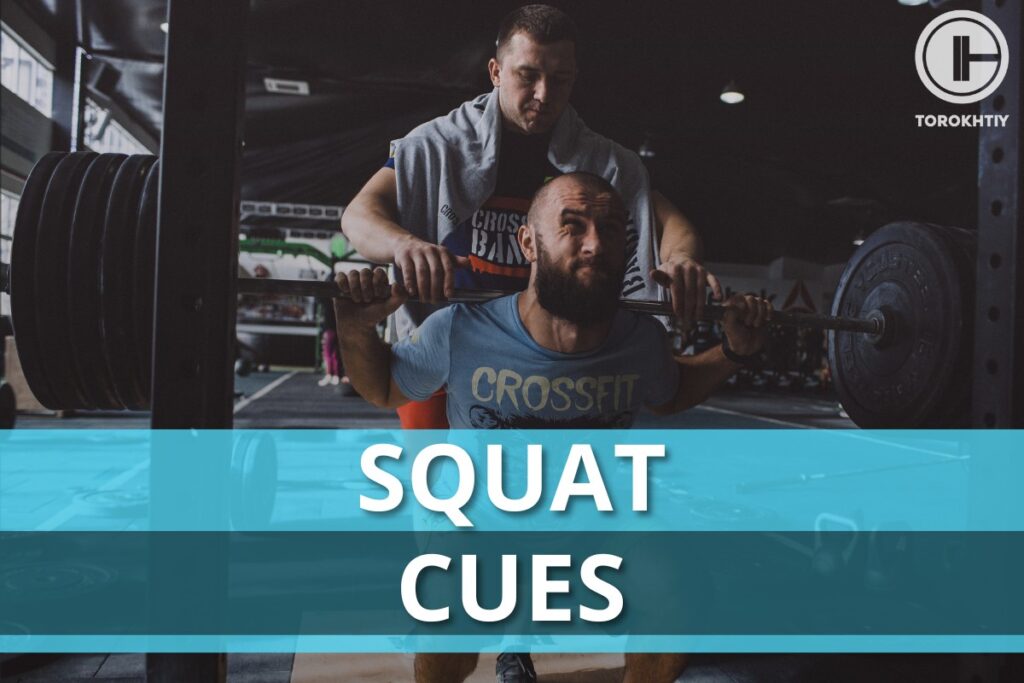
The Importance of Proper Squat Technique
Working out is all about form and technique. If you do an exercise with your form being off, it ends up being a waste of time. Squats are not an exception to this and there are several reasons as to why form is so important.
When you do squats the correct way, they engage multiple muscle groups and help you develop your quads, hamstrings, glutes, and core muscles. They also improve stability and the mobility of your joints. Proper technique is very important to prevent injuries, especially in the lower back, knees, and hips.
When you brace your core, keep the chest up, and maintain a neutral spine, you’ll protect your back from excessive stress and strain. But proper form does more than just injury protection – it optimizes muscle engagement, or in other words, lets you get the most out of your workout.
Believe it or not, doing squats the right way has benefits that go beyond the gym. Squats mimic functional movements that are essential for your daily life, like sitting, standing, and lifting things. Squats can help you develop a strong foundation, improve your overall physical performance, and protect you from injuries in everyday life.
You’ll also notice improvements in your posture because squats target the muscles that contribute to maintaining an upright posture. Sedentary lifestyle is extremely common these days and it leads to a lot of issues, including poor posture that can cause musculoskeletal issues, so make sure to exercise the muscles that can prevent it.
Follow us!

Free!
Get a 2-week Weightlifting Program as a bonus for the subscription to kickstart your training plan!

Free!
From the point of view of fitness goals, you won’t be able to progress without the correct squat technique. When you do them the way you’re supposed to, you activate all the muscles you should, and that helps them grow and promotes strength development. Proper technique will minimize the risk of overtraining and muscle imbalances, which lead to injuries. As you progress, you’ll be able to increase the resistance, which means there’s less chance of reaching plateaus and you’ll continuously develop your strength and fitness in general.
So that’s that on physical benefits, but we can’t forget the ones regarding your mental health. Squats are pretty hard to do, especially in the correct way, so once you manage to do them, it brings about a sense of accomplishment and confidence. The focus you need to maintain proper squat form can help with mental resilience and discipline that can translate to different aspects of your daily life.
3 Types of Squat Cues
Mastering squats is no small feat, but you can get some help from cues for squats, which can be categorized into three main types: verbal, visual, and tactile.
Each type is different, and if you want to know which is best – that depends. Try them out, see what works and what doesn’t and go from there. Essentially, there’s really no reason to choose because all types of squat cues are useful.
1. Verbal Cues
These cues are spoken instructions or reminders that guide you through the squat movement. They mostly come from coaches or training partners, but they can even be self-directed. And that doesn’t mean speaking to yourself (although, if it works, more power to you), it’s an internal dialogue.
A verbal cue you’ll hear really often is “chest up”, which will remind you to keep your torso upright during squatting. Another common one is “knees out” to encourage you to align your knees properly and prevent inward collapse.
Verbal cues are great because they let you adjust on the spot, but they will also help you develop a mental checklist for doing squats with precision.
2. Visual Cues
A visual cue can be looking at yourself in the mirror, watching an instructional video, or asking others for feedback.
A mirror is a great choice because you get real-time feedback on form, so you can make adjustments right then and there. Instructional videos, on the other hand, give you visual references for correct squat mechanics. If you’re training alone, you can even record your training and then review the footage.
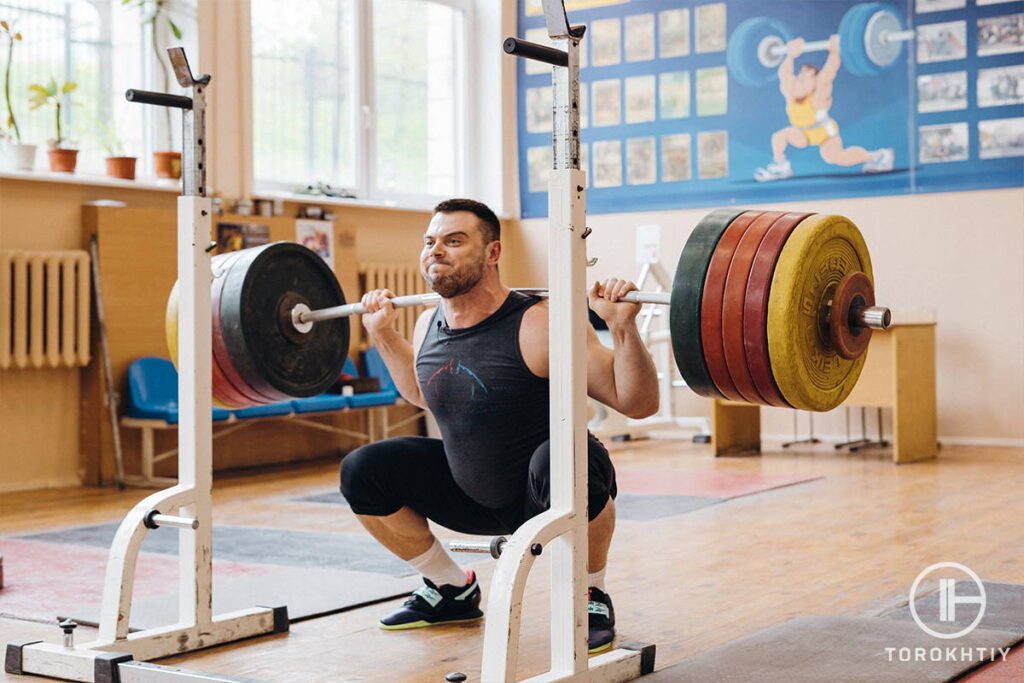
This might sound a bit over the top, but having a video recording is very useful because you can notice subtle form deviations, foot positioning, or depth issues that you may not have noticed during the actual lift. This visual feedback is really valuable because you can see what needs to be corrected and that plays a big part in improvement.
3. Tactile Cues
Physical touch or sensations are tactile cues that help you maintain proper form. Usually, these cues come from coaches or training partners.
For example, a coach can use a tactile cue to gently adjust your back position or help you find the right depth. If you’re training alone, tactile cues are probably not your first choice, but they can still be done. You can use props or markers to improve body awareness.
You see, it isn’t about choosing the best type. You may have ones that you prefer over the others, but all cues play a part when it comes to refining your form and mastering the perfect squat. And don’t be shy to turn that camera on – it can be a little bit weird at first, but seeing yourself squatting and being able to focus and nitpick your technique is a helpful companion like no other.
| CUE TYPE | DESCRIPTION | EXAMPLES |
|---|---|---|
| Verbal Cues | Spoken instructions or reminders guiding your movement. They usually come from coaches or training partners, but they can also come from internal dialogue. | Common cues are “chest up” to keep the torso upright and “knees out” for proper knee alignment. Verbal cues let you make adjustments on the spot. |
| Visual Cues | Mirrors, instructional videos, or feedback from others. Mirrors give real-time feedback on form, while videos help identify subtle deviations. | Instructional videos can be used for references, mirrors for real-time adjustments, or recordings for in-depth analysis. |
| Tactile Cues | Physical touch or sensations that help you maintain correct form, provided by coaches or training partners. Can also be done without a partner through props. | Coaches can use tactile cues to adjust back position or depth. Training alone can involve props or markers to improve body awareness. |
External vs Internal Cues: Key Differences
If you want to improve your form, you need to know about the difference between external and internal cues.
External cues direct your attention to aspects of the environment or external objects and guide your movement by focusing on the outcome or effect. For example, an external cue could be directing the attention to the floor, meaning you need to push through your heels. This external focus often makes your movement patterns more instinctive and efficient.
Internal cues, on the other hand, direct your attention to body parts or sensations, and their focus is movement mechanics. An internal cue for squats could involve focusing on contracting the glutes.
Make no mistake, both of these types are useful, but some studies suggest that external cues tend to result in better performance and more natural movement patterns. Squats are complicated, and the reason external cues are so good is that they simplify complex movements and help you do them in a more automated, fluid manner.
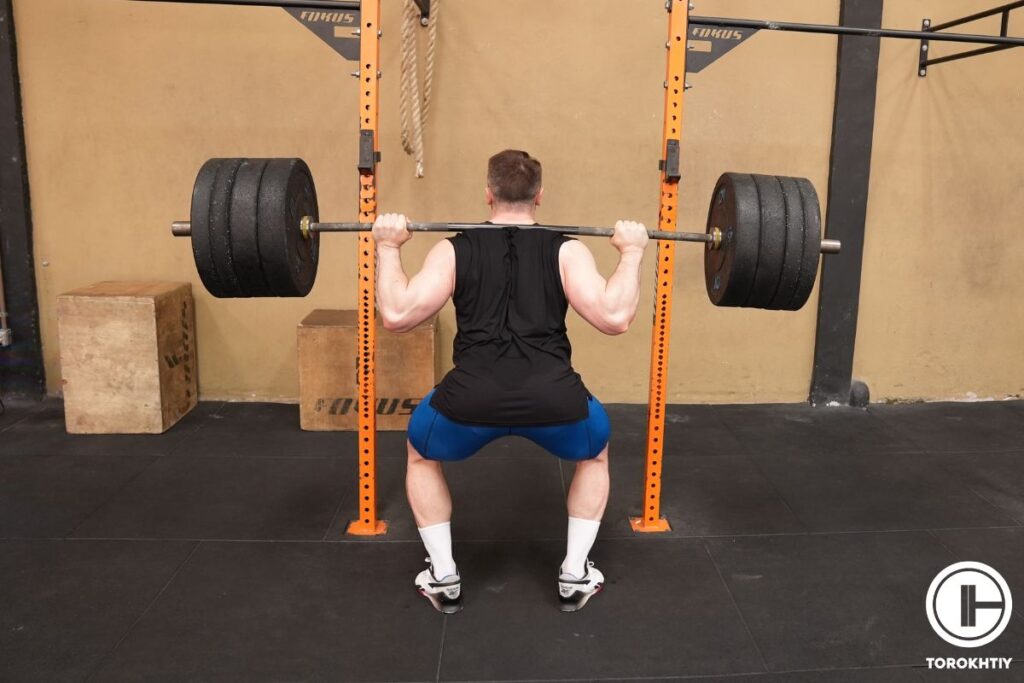
Let’s explain this through an example. Since they don’t fixate on specific body parts, external cues help you concentrate on the overall outcome of the squat. For instance, an external cue like “push the floor away” encourages you to engage multiple muscle groups and get a more powerful ascent. This approach goes hand in hand with the natural coordination of the body during functional movements.
ther than this, external cues improve proprioception, which is the way your body is aware of its position in space. If your awareness is directed externally, you’ll get a better sense of how your body interacts with the surroundings, and that can translate to improved balance and stability during squatting.
They’re really effective at promoting optimal joint alignment and reducing the risk of injury. For example, a cue like “spread the floor with your feet” will encourage proper knee tracking and prevent inward collapse. External cues give you a more intuitive understanding of how your body should move as a coordinated unit and they tap into your body’s natural ability to respond to external stimuli, which makes your squats smoother and more controlled.
But do you want to know what people like best about external cues? It’s the fact that they can help you lift heavier loads. When you’re trying to get through a challenging lift, the cue “drive the bar through the ceiling” can improve your stability and force production.
his shift in focus from internal mechanics to the outside outcome makes it easier for you to push through those nasty mental barriers and do a more powerful squat. It gives you a chance to develop a mindset whose priority is successfully executing the lift instead of getting bogged down by intricate details.
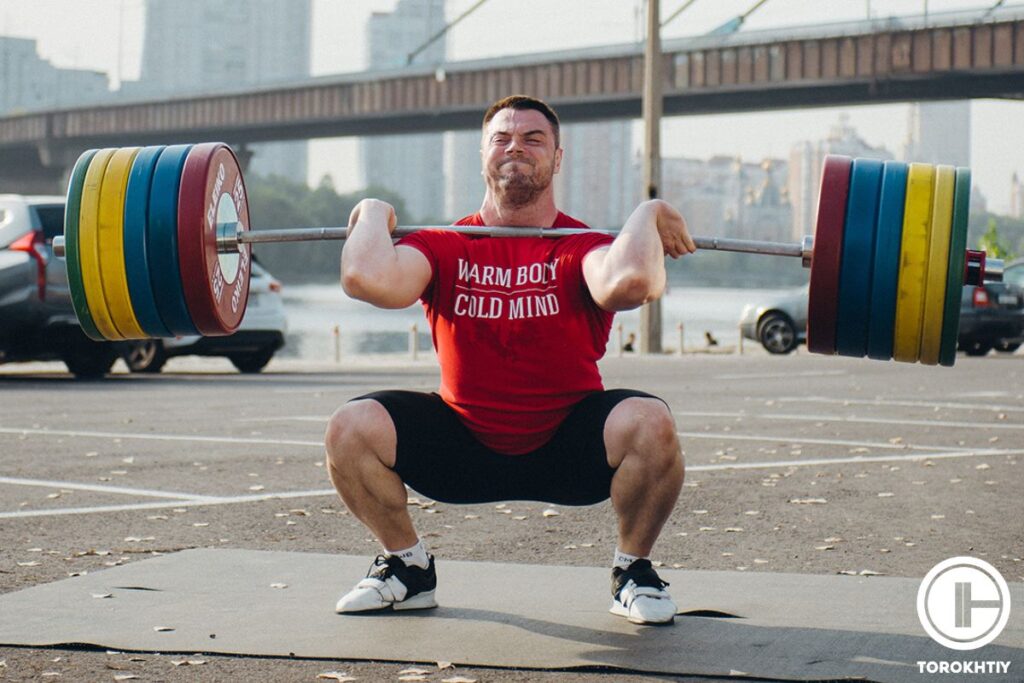
So, if external cues direct the attention outside, that means internal cues shift it inside. Internal cues focus on contracting specific muscles or joint movements and they’re good if you want to refine your form and target specific areas.
However, if you fixate on them too much, you will end up overthinking and that can cause disruptions in your movement patterns. Say you’re concentrating on how your knees are positioned or what angle your hips are at – your squat can turn out less fluid and more segmented. Although they have their place in squat training, the ones who will benefit most from them are people with mobility issues or those that want to isolate specific muscle groups.
If you’re working on developing a better mind-muscle connection, which is a necessity in general, you’ll want to combine external and internal cues, and the same goes for people who are addressing issues with mobility and beginners.
Squat cues for beginners need to include both internal and external ones. A cue like “squeeze the glutes at the top” will help activate the posterior chain. Use both types of cues strategically and you’ll get a well-rounded training that has the benefits of improved performance and targeted muscle engagement. Why settle for one when you can have both?
| ASPECT | INTERNAL CUES | EXTERNAL CUES |
|---|---|---|
| Focus on Attention | Attention directed to body sensations or specific body parts | Focus shifted to aspects to the environment or external objects |
| Example | “Squeeze the glutes at the top of the squat” | “Push the floor away with your feet” |
| Effect on Movement | Focus on isolated muscle contractions or joint movements | Promote more natural and coordinated movement patterns |
| Benefit for Form | Beneficial for refining form and targeting specific muscle groups | Better overall form and joint alignment |
| Risk of Overthinking | Excessive focus on internal cues can result in overthinking | External cues make complex movements simpler and reduce the risk of overthinking |
| Application to Beginners | Helpful for developing a mind-muscle connection and learning proper mechanics | Very effective for beginners, provide a more intuitive approach to movement |
| Improved Proprioception | Improved through directing attention to specific body sensations | Improved through awareness of the body’s interaction with the environment |
| Better Performance | Good for isolating muscles, but may not lead to better performance | Improve overall performance, promote a coordinated approach to movement |
| Risk of Disrupted Flow | Might cause segmented, less fluid movement pattern | Encourage a more natural, fluid flow of movement during exercises |
8 Common Squat Cues to Improve Your Squat Form and Technique
You might make the common mistake of thinking proper squat form is all about lifting weights, but it’s actually about doing a compound movement that engages multiple muscle groups, while protecting your body from potential injuries. This is where back squat cues come in – to direct your body through the movement and make sure each rep is not only effective but also safe.
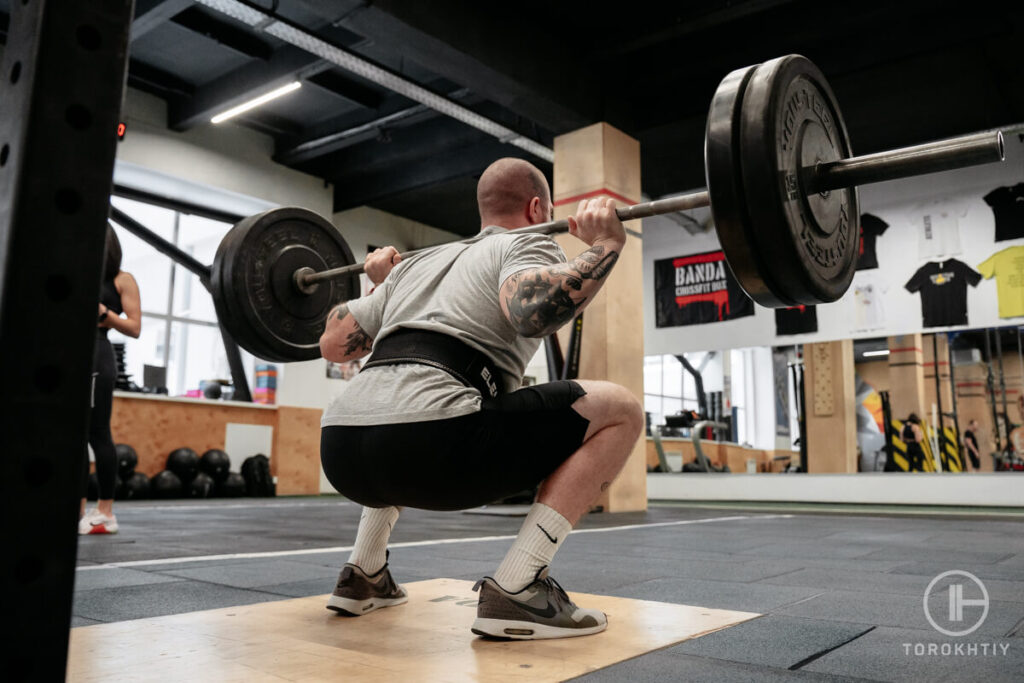
1. Brace Your Core
This cue means you’re supposed to tighten the muscles around your abdomen, which will provide stability to the spine during the squat. Think of it as a natural weightlifting belt that protects your lower back by preventing excessive spine flexion. If you brace the core, you’ll also improve overall body control, which means your squat can be more controlled and powerful.
2. Keep Your Chest Up
Keeping your torso upright throughout the entire squat is super important, so of course, there’s a cue to remind you of that. A lifted chest helps preserve the natural curvature of the spine, which prevents rounding or leaning forward too much. This protects your back and makes sure the load is distributed evenly, so the squat is more biomechanically efficient.
🔻GET A FREE PROGRAM DEMO: 12 Week Squat Program by Oleksiy Torokhtiy
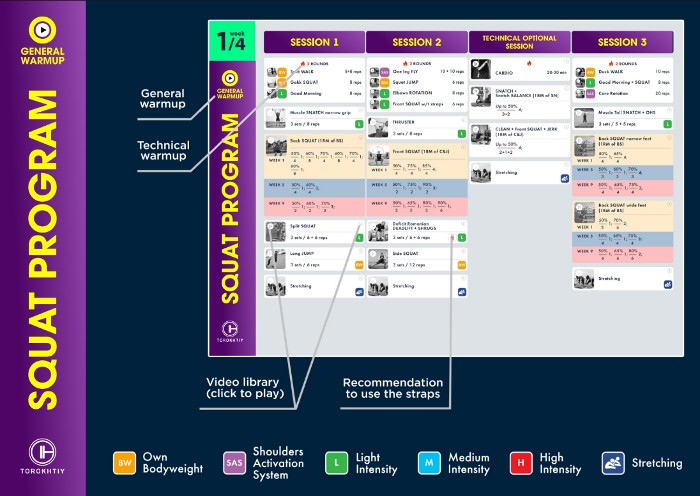
Do you want to double your squat strength? In just 12 weeks, you’ll be able to boost your squat results.
Enter your details and get a free demo (1 free week) of the squat program straight into your inbox.
3. Hips Back and Down
Start the squat by pushing the hips back before bending your knees to make sure the posterior chain is properly engaged. This movement pattern makes your hamstrings and glutes maximally involved, so the load is distributed across the hip and knee joints. It contributes to a stable and balanced descent, and avoids putting too much stress on any specific group of muscles.
4. Knees in Line with Toes
Make sure the knees track over the toes, so your joints remain properly aligned. This cue reduces the risk of valgus collapse, where the knees cave inward. When your knees are aligned the way they should be, the load is distributed evenly across your lower body and your knees don’t handle more stress than they’re supposed to.
5. Maintain a Neutral Spine
When your head, neck, and lower back are aligned, your spine is in a neutral position. This distributes the load evenly along the vertebral column and lessens the chance of your lower back being injured. This cue is absolutely fundamental for maintaining structural integrity and ensuring that the spine is well-supported during the entire squat.
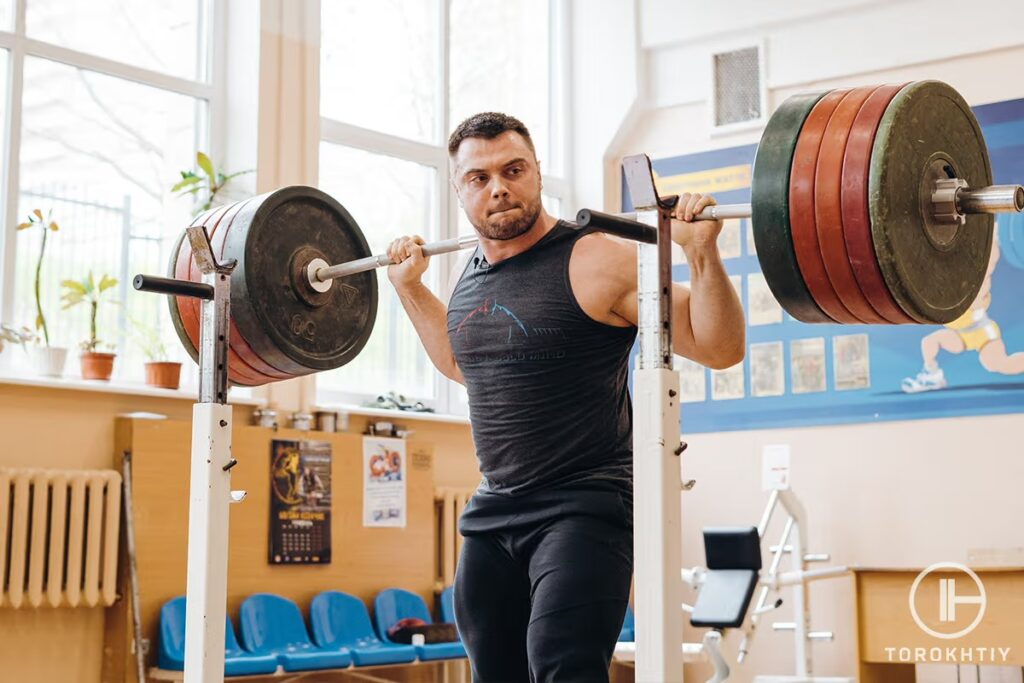
6. Drive Through Your Heels
This cue shifts the focus to the glutes and hamstrings, which means the distribution of force is more balanced. Driving through the heels prevents the weight from shifting forward onto your toes, improves stability, and minimizes the stress that’s placed on your knees.
7. Controlled Ascent and Descent
When you squat with a controlled ascent and descent, you resist the pull of gravity during both of these phases. This cue makes sure that the muscles are engaged throughout the entire range of motion. The controlled descent activates the muscles eccentrically, helps develop strength, and prevents injuries. It’s also important for a powerful ascent.
8. Depth Control
Many people struggle with depth, and achieving it means you need to lower your body until the hip crease goes below the top of the knee. The cue ensures that the squat targets the full range of motion and engages the quads, hamstrings, and glutes. Reaching the correct depth contributes to functional strength, flexibility, and developing your lower body in general.
FAQ
What Are the 3 Best Cues for a Good Squat?
The 3 best, most effective barbell squat cues are “brace your core”, “hips back and down”, and “drive through your heels”. The first one means you should tighten your abs for spine stability, the second encourages you to start the squat with engaging the posterior chain for a balanced descent. The last one stabilizes the movement and prevents the weight shifting forward onto your toes.
What Are the Safety Cues for Squats?
Safety cues for squats are really important for preventing injuries. The first one is to “maintain a neutral spine” by aligning your head, neck, and lower back. This makes sure the weight distribution is even and there’s less chance of you injuring your lower back.
The second, “knees in line with toes”, is meant to prevent inward collapse and protect the knee joints. The third, “controlled descent and ascent” promotes muscle engagement and minimizes the risk of strains.
Conclusion
Squat form cues are not miracle workers and you’re still the one doing all the heavy work – just with a little bit of help from the outside. It’s great if you have a training partner or a coach because you can adjust your form on the spot based on their cues.
If you prefer working solo, that’s fine, too, because there are cues you can use just by yourself. One of them is literally talking to yourself (out loud if you’re one of the few that are comfortable with it, or just as internal monologue if you’re not), but one of the best things you can do is to whip out a camera and record your training. The video footage will let you pick your squat apart and see what you’re doing incorrectly. You can also use a mirror if you prefer real-time feedback.
Whatever you decide on, just make sure you’re safe, respect your body’s limits, and don’t rush into anything. It can be tempting to try and push your limits before you’re ready for it, but more often than not, that just leads to injury.
What are your thoughts on squat cues? Do you prefer them coming from another person or are you a fan of internal dialogue? Have you ever thought of recording your squats, and if you’ve tried it, how did you like it? Which cue do you think is the most effective?
Leave your questions, comments, tips, and suggestions – all of it in the comments section below!
Also Read:
- 11 Squat Accessory Lifts to Boost Your Squat Results
- Why Is My Squat So Weak? 6 Possible Reasons Explained
- Why Do My Legs Shake When I Squat?
- Why Do My Legs Hurt So Much After I Do Squats?
- What Muscles Do Squats Work? (Lifting Coach Explains)
- Squatting With Long Femurs: Tips For Lifters With Long Legs
- Squat Pyramid: What Is It & How To Create Your Own
- Squat and Deadlift Same Day: Right or Wrong?
- Spotter’s Handbook: How to Spot a Squat?
References:
- Jacklyn Joseph, Tengku-Fadilah Kamalden, Qais Gasibat, Shamsulariffin Samsudin “Occurrence of Muscle Imbalance and Risk of Injuries in Athletes using Overhead Movements: A Systematic Review,” Sport Mont Journal 19, no. 3 (2021): 3-10.
- Joaquin Calatayud, Jonas Vinstrup, Markus Due Jakobsen, Emil Sundstrup, Mikkel Brandt, Kenneth Jay, Juan Carlos Colado, Lars Louis Andersen “Importance of mind-muscle connection during progressive resistance training,” European Journal of Applied Physiology 116, no. 3 (2016): 527-533.
- Kate Neudecker “Learn How to Do Front Squats to Fire up Your Quads and Light up Your Core,” Men’s Health, https://www.menshealth.com/uk/how-tos/a735538/front-squat/ (accessed February 12th 2024)
- Lena V. Kallings, Victoria Blom, Björn Ekblom, Tobias Holmlund, Jane Salier Eriksson, Gunnar Andersson, Peter Wallin, Elin Ekblom-Bak “Workplace sitting is associated with self-reported general health and back/neck pain: a cross-sectional analysis in 44,978 employees,” BMC Public Health 21, Article number: 875 (2021).
- Lindsay V. Slater, Joseph M. Hart “Muscle Activation Patterns During Different Squat Techniques,” J Strength Cond Res 31, no. 3 (2017): 667-676.
- All photos are made by our Torokhtiy Media Team
Why Trust Us?
With over 20 years in Olympic weightlifting, strength training, nutrition coaching, and general fitness our team does its best to provide the audience with ultimate support and meet the needs and requirements of advanced athletes and professional lifters, as well as people who strive to open new opportunities and develop their physical capabilities with us.
By trusting the recommendations of our certified experts in coaching, nutrition, and sports training programming, as well as scientific consultants, and physiotherapists, we provide you with thorough, well-considered, and scientifically proven content. All the information given in the articles concerning workout programming, separate exercises, and athletic performance, in general, is based on verified data.
The product testing process is described in more detail here.
Author: Jason Li
Personal Coach, Functional Range Conditioning Mobility Specialist
Jason is an NYC personal training expert and National level Olympic Weightlifting Coach with over 10 years of experience training everyday clients to high levels of performance. He has trained everyone from youth (13 years old and under) to masters (60+ years old) to regional and national rankings for powerlifting, Olympic Weightlifting, Short distance (up to 200m) sprinting, discus & hammer throwing.
Reviewed by: Oleksiy Torokhtiy
Olympic Weightlifting Champion, PhD in Sport Science
Best Results: Snatch – 200 kg,
C&J – 240 kg
Oleksiy Torokhtiy is a professional athlete boasting 20 years of experience in Olympic weightlifting. With multiple European and World titles under his belt, he has showcased his prowess in two Olympic Games (Beijing 2008 and London 2012). Upon concluding his illustrious career, Oleksiy dedicated himself to coaching. By 2022, he had conducted over 200 weightlifting seminars worldwide. He is the visionary behind an international sportswear and accessories brand known for its motto, “Warm Body Cold Mind.” Additionally, he is an esteemed author and the creator of a series of training programs and eBooks.




Still have questions after reading our article? Unlock your full potential by engaging with our experts and community! Don’t hesitate — leave a comment below and Jason Li will provide a personalized answer and insights to help you reach your goals.